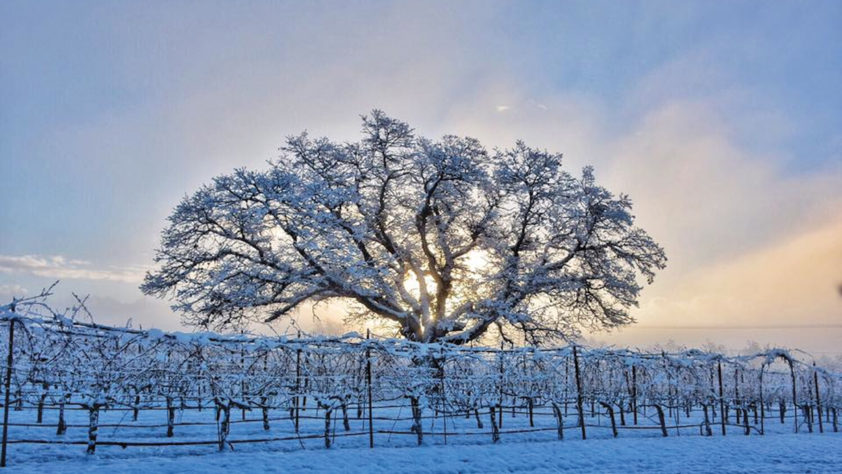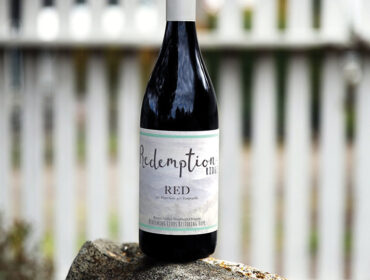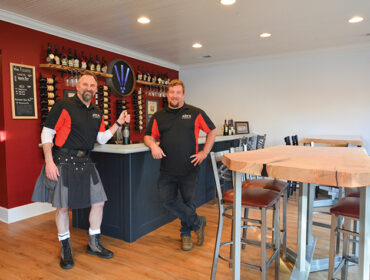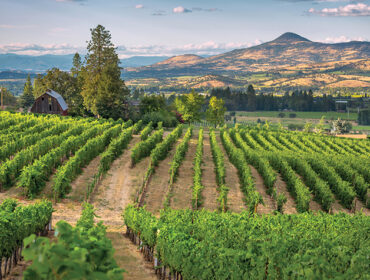
A Year in the Life: Winter in the Wine Scene – by MJ Daspit
The rush of harvest is over. The crush pad is idle. The bird netting is rolled up and put away. The vines stand naked under a leaden sky and the only apparent activity is a hawk circling overhead. But as Wine Scene found out from Dan Marca, owner of DANCIN Vineyards; Liz Wan, assistant winemaker at Serra Vineyards; and Chris Graves, winemaker at Naumes Crush and Fermentation, the appearance of inactivity is deceiving.
Reflecting on his winter schedule, Marca observes, “People think if the harvest is done we can rest. We can rest from harvest-specific activity, but you don’t really rest. When you have a winery and a tasting room and you’re a farmer, it’s year round. I met with a winemaker a few weeks ago and her comment to me was the reason she doesn’t want to have a winery and tasting room is because it’s year-round full time plus.”
Though seated in a comfortable chair overlooking the vineyard, Liz Wan sounds just a little hyper when asked to describe what’s going on at Serra. “Last year during this week I was literally shoveling snow on the back crush pad because I couldn’t get the pallet jack under the barrels over the snow. This year we’re trying to prune as fast as possible to get out ahead of what we expect will be an earlier push for bud break. Also because it’s so mild we can check our irrigation. Usually you don’t want any water in those lines because they’re going to freeze and burst, but this year that hasn’t been an issue yet, so we’re doing a lot of checking for broken lines and emitters.”
Graves adds, “In winter we’ll do soil adjustments (addition of nutrients or amendments to help soil structure and water holding capacity) and pruning. Pruning is the big job. It’s a major viticultural practice; it dictates the way your vines are going to grow and dictates your crop yield. It’s extremely important to do it well and it’s a lot of work, all done by hand.”
At DANCIN pruning can occur twice, the first time leaving intentionally long spurs (vertical bud-producing canes) as a measure to insure against loss of buds to frost. “With basic spur pruning we keep only one or two buds on each spur. With double pruning, you leave a lot more, meaning you’re going to come back and prune again,” Marca explains. “Grape vines have apical dominance, so those buds furthest away from the trunk are the ones that come out first, counterintuitively. When we have a freeze event—we had one on May 14th a few years back, 31 degrees for 6 hours—the buds at the end of the spur, our sacrificial buds, turned brown and brittle during the freeze. The basal buds nearest the trunk were not yet out of their ‘cocoons,’ as I call them, so they were salvaged and we only lost 5% of new growth. Now we have a wind machine so we double prune less, but it’s still a decision that we make on an annual basis.”
Shifting to what goes on inside the winery, Graves says, “The highest priority is to make sure the new vintage is cared for by tracking fermentations, getting all the reds put to bed. We’re also gearing up to bottle the new whites and rosés, last year’s reds or even two-year-old reds.”
Wan puts it in a nutshell. “Between now and bud break, anything you can do, you do it. Once we have bud break we’re running to keep up with our vines, the tasting room is starting to get busier… all the events start to happen. So for us, we’re doing blending trials, adjusting last year’s whites and the reds that have been in-barrel for a couple of years to prepare them for bottling, assessing how much we want to bottle, and booking trucks. We use a mobile bottling van except for lots of less than 150 cases which we hand bottle.”
Graves explains the emphasis on bottling. “There’s only so much room in tanks—you have to empty tanks. Managing resources of the winery is absolutely huge. Some of that might be dictated by barrels as well, which are the number one cost behind the grapes and sometimes actually higher. If you’re able to empty your barrels before the next vintage, that’s a huge savings, because you don’t have to invest in new ones—until they get to be about four years old.”
Like Serra, Naumes uses a mobile bottling line that arrives in a tractor trailer at the winery. “The mobile bottling line has a lot of advantages,” Graves explains, “It’s very professional, high quality bottling, and fast. The problem is you need to have everything very well prepared. When the truck comes in you gotta rock and roll. If there are any issues with the wine or the packaging, and they have to slow down or stop, they start charging you a fortune—like $500 an hour. So you have to make sure all your ducks are in a row and everything’s completely dialed in. It’s really kind of stressful for the winemaker and staff to get everything ready, but assuming you do, the truck comes in and you fire out 1,2,4, or 6 thousand cases, then afterwards it’s a huge sigh of relief.”
And for every tank or barrel emptied, Wan points out, there’s maintenance. “We had primary fermentations going on most of December, so now most of us are cleaning our tanks, cleaning our bins. We’re also maintaining our fork lift, bobcat, four-wheelers, and putting away press equipment and conveyors.”
She adds, “We also do lot of analysis this time of year. Titrations for SO2, (sulfur dioxide) for example, take fifteen to twenty minutes per lot to run, so you can spend a whole day doing that. Fining, racking and returning are all happening.”
Marca sums up. “Besides watching over the wines, topping, tasting, monitoring the malolactic fermentation, looking at blending and bottling, it’s year-end inventories. It’s taxation.”
Wan concurs. “The Oregon Wine Board reports were due at the end of the year. There’s a lot of counting and accounting happening—also invoicing for grapes sold.”
With his trademark emphasis on hospitality, Marca speaks to the winter preparations necessary to a successful season in the tasting room. “Now we’re starting to reach out and determine who’s the team. What personnel do we need? Where do we find them? What does training look like? What have we learned from last year’s training? We have a training manual. We’ve established certain procedures about how service is done, how the wine is presented, how it’s opened, how it’s poured, everything.”
Wan says winter is also the time for “revamping the website, putting all the new events on the events page, booking bands, scheduling wine dinners, checking what wholesale is looking like.” Being proactive about wholesale, she notes, “Restaurants are changing their wine lists to put out the new selection by Valentine’s Day.”
And several weeks after Valentine’s Day, comes spring, and with it, our next installment of A Day in the Life. Wine Scene will talk to another group of wine industry professionals to get the low down on what goes on in the vineyard, the winery and the tasting room with the coming of bud break.
Photo: Winter Tree at Agate Ridge by Ashley Cates
©Southern Oregon Wine Scene
Fall Winter 2018 issue
Related Post
RoxyAnn Winery–Making a Difference with Redemption...
Update to this article on 07/29/21 – “… the Board of Directors of Redemption Ridge have made the difficult decision to clo...
Awen Winecraft: An Inspirational New Reason...
As if you needed another reason to visit historic Jacksonville, now there’s another draw—Awen Winecraft’s new tasting room located at ...
Rogue Valley Rising – by Valerie...
MEDFORD, OREGON’S star is rising on the world stage as it rapidly becomes a top destination for connoisseurs of fine wine and for enthusia...




